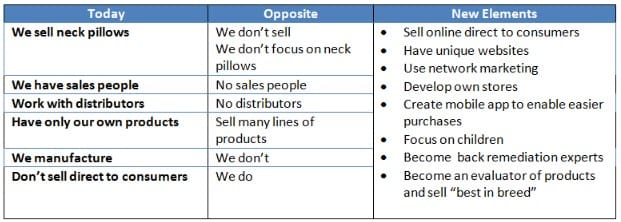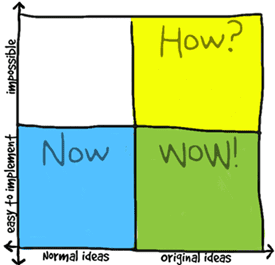In my previous blog on Innovation Games, I talked about how “serious games” have the power to change the way you work, approach problem-solving, and seek out new buyers of your product or service. How do they do this?, you might be asking. What’s the secret sauce? In a word, collaboration. Innovation Games work so well because participants come together as a team to generate new ideas and new ways of offering customers what they want.
Playing games allows your teams to develop growth strategies and business solutions in a non-threatening way.
That’s because there is no such thing as a bad idea when someone engages in play. Play allows people to be creative without fear of failure, to think out of the box without risk. At SAMC, we use Innovation Games with many of our clients and have found that in most situations, they are far better than brainstorming sessions or focus groups.
Why use Innovation Games?
1. They help develop brand strategy. We have had great success with Innovation Games when clients needed help developing brand positioning. One healthcare client even allowed us to work with their employees and customers. What they learned from “playing serious games” helped them gain a preemptive position in a cluttered marketplace, develop a robust brand copy strategy, and generate significant qualitative data for an internal rebranding campaign.
2. They help define consumer need. A few years ago, we led an Innovation Games session for a group of consumers who were searching for a new type of financial services. Prior to playing the games, these consumers had difficulty defining or even describing what they needed, yet they were dissatisfied with their experiences in the marketplace. Innovation Games helped them shape their issues and then devise a solution. This direct-from-the-consumer articulation gave serious direction to financial services organizations, enabling them to develop targeted offerings that were consistent with consumer need.
3. They help define products. Another client we introduced to game-playing was a plumbing hardware manufacturer. I remember the CEO saying to us, “Don’t expect many new ideas. These guys are engineers.” Well, using games, we developed SIX great ideas.
4. They help set priorities. For an IT company, we used a game called “Prune the Product Tree,” whose objective is to identify the roots of the tree, the trunk, the branches, the leaves and the fruit. This helps participants determine what is essential and what needs to be harvested or pruned. Prioritizing their assets enabled them to eliminate unneeded elements so they could be more streamlined and profitable.
How to choose the right Innovation Game? Focus on these 5 criteria:
1. The number of people who can play the game at any one time.
2. Supplies or materials necessary to play the game.
3. How much background education is necessary to provide data or content for the game.
4. Degree of customer preparation: what pre-game activities, if any, should you require of the participants before entering the game environment.
5. Time frame: how long after the game finishes should participants expect a product or service to improve to reflect the game’s results.
Here are some of our favorites:
1. Reverse Everything
If you want to get a small group of people to create an amazing number of ideas quickly, try “Reverse Everything.” Here is how it works:
- List all your assumptions about you today.
- Reverse each assumption.
- Ask yourself how to accomplish a goal with new ideas.
- It’s not about changing your mind. It’s about finding other possibilities that exist and making different choices.
For instance, if you sell neck pillows:

2. Build a Better Product Box
One of the original 12 games that started it all, this exercise helps you identify the most exciting features of a product or service, as revealed by your customers.

Begin by asking your customers to imagine that they’re selling your product at a trade show, retail outlet or public market. Give them a few cardboard boxes and ask them to literally design a box that represents your product or service. It might have key marketing slogans or tag lines that refocus the company in new directions. When they’re finished, pretend you’re a skeptical prospect and ask them to “sell” their box to you. Who sells the best?
3. Remember the Future
This one takes a backward-planning approach that works well to help people see where they want to go by seeing how they got there.

4. Now/Wow/How
This is one of the simplest, most useful and most popular games that we use because it forces people to prioritize. The Now/Wow/How matrix is an idea selection tool that breaks the “creadox” (creative paradox) by forcing people to weigh each idea on 2 parameters: ability to implement (easy vs. impossible) and quality of the idea (normal vs. original). As you’ll find out, it’s a lot harder than it looks!

We invite you to give these games a try and see what you come up with!
As trained Innovation Games practitioners, we would love to tell you more about how this revolutionary approach to business growth could help your company “see, feel and think” in new ways and convert those new ideas into effective innovations. If you would like to schedule a workshop or training program, or just talk about how Innovation Games could help your business, please contact us. We look forward to hearing from you.
From Observation to Innovation,
Andi Simon, Ph.D.
CEO | Corporate Anthropologist | Author
Andisimon.com
Info@simonassociates.net
@simonandi
LinkedIn



